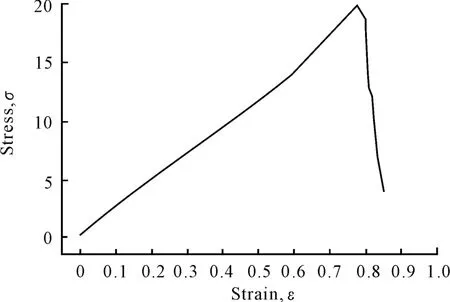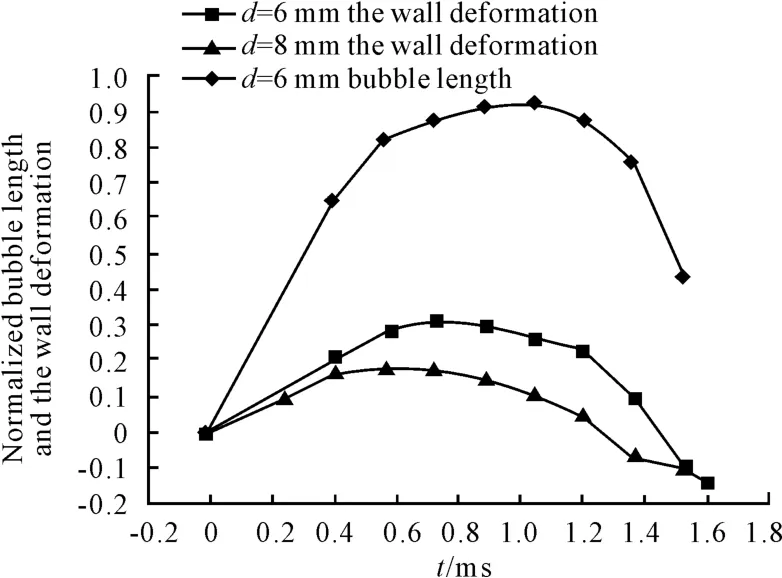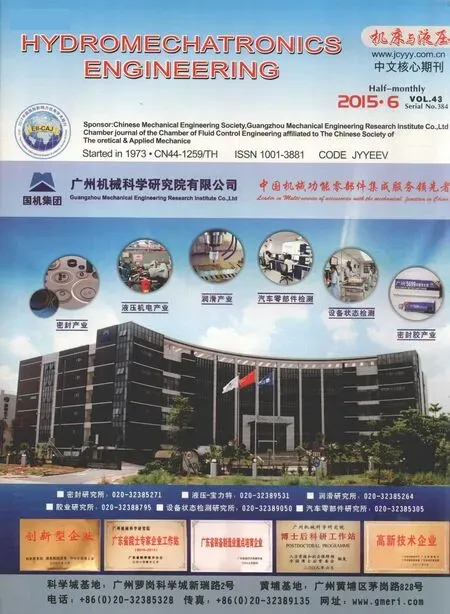Visualization study of the oscillating bubble near the elastic wall
Ming XU,Guo-liang HU
(School of Mechatronics Engineering,East China Jiaotong University,Nanchang 330013,China)
1 Introduction
The bubble dynamics near the wall has been investigated by many researchers[1-4].The interest in cavitation bubble dynamics near the wall mainly arose from the bubble’s destructive action on the surface.In recent years,owing to the potential use in drug delivery and thrombus removal and so on,the cavitation application in the biomedical has attracted interests of scientists around the world.The interaction between the bubble and the elastic wall plays an important role in many biomedical applications.The elastic properties of the wall strongly influence the bubble dynamics.A comprehensive experimental study on the interaction of the bubble with elastic wall is performed by the Erujan et al[5].The complex behavior of bubble near the elastic wall is observed in the experiments for the force acting on the bubble.Numerical model is used to simulate the bubble dynamic behavior near the elastic wall including the bubble formation of the annular flow,bubble splitting and collapse jet[6-8].
In recent years,the research of the bubble oscillating in the elastic pipe was focused on the numerical simulation.The coupled wall element-finite element code was used to investigate the interaction of a bubble and a deformable tube[9].A theoretical model for the dynamic of a bubble in an elastic blood vessel was applied to numerically study the effect of confinement on the free oscillations of a bubble[10].Asymmetrical oscillation of a micro-bubble confined inside a deformable pseudoelastic vessel with comparable initial radius with the bubble was studied in details[11].
Since the biomedical tissue wall always is elastic,the comprehension of the cavitation bubble dynamics behavior near the elastic wall becomes essential.At the same time,few studies were done on the bubble oscillating in the elastic pipe.We investigated the bubble interaction with the elastic wall including elastic pipe through experiments.The elastic wall consists of the ballistic gelatin which is used as the phantom of the body tissue.The interaction of the oscillating bubble and the elastic wall was studied in details.The dynamic process of the cavitation bubble was recorded by a high speed video camera.
2 Experimental setup
A schematic diagram of the experimental setup is shown in the Fig.1(a).The bubble oscillates in the elastic pipe.The cavitation bubble is generated by a simple low voltage electric spark discharge circuit which is similar to those in references[12-13].The size of water tank is 20 cm×20 cm×30 cm with the water depth of 20 cm.A pipe with both open sides is immersed in the water and horizontally placed at the middle of tank,below the water surface with 10 cm.The electrodes which are inserted inside the pipe was used to create an oscillating bubble.Compared with other generating method of single cavitation bubble,such as acoustic wave and laser,the spark-discharge method used in the experiment was more simple and low cost.In order to minimize the interference,a very fine tungsten wire with 0.3 mm diameter was used as electrodes.The maximum diameter of bubbles generated by spark discharge is about 20 times bigger than that of the electrodes.As shown in Fig.1(b),the bubble oscillates near the elastic flat wall.The maximum bubble radius Rmaxin horizontal direction,the stand-off distance H are presented.In the Fig.1(c),the bubble oscillates in the elastic pipe,the pipe inner diameter d and the bubble maximum axial length Lmaxare given.

Fig.1(a)The experimental setup(b)The bubble oscillating near the elastic flat wall(c)The bubble oscillating in the elastic pipe
In order to capture the details of the rapid oscillating motions,a high speed video camera(FASTCAM-ultima APX,USA)fitted with a Nikkor 60 mm micro lens was used in this experiments.The flickerless backlighting was produced by a high-intensity LED lamp with a thin sheet of drafting paper as a diffuser.Images were captured by the high speed video camera.The tap water in the tank and laboratory temperature was kept at 25℃.
The circuit used to generate the electrical spark was made up of a 60 V voltage source,a 3 000 μF capacity,a 1 kΩ resistor and a switch.Firstly,the switch was set on the right,and the capacity was charged by the electrical source until the potential difference across the capacity reached 60 V.Then the switch was shifted to the left.The electricity stored in the capacity was discharged instantaneously to generate the spark at the electrodes.
The elastic material used in our experiment was ballistic gelatin.The ballistics gelatin was widely used as a soft tissue stimulant in physical surrogates for the human body to evaluate penetrating impacts and,more recently to evaluate blunt impact and blast loading effects on soft tissues[14].Gelatin powder was produced from biological materials(skin,bone and tendons)through extraction by using hot water in an acidic(type A)or alkaline(type B)environment.The mechanical properties of the gelatin were known to be sensitive to temperature and condition or aging of the gelatin[15-16].The ballistic gelatin could be used to the phantom of the body tissue wall to investigate the bubble-tissue interaction.
Fig.2 was stress-strain curve of the 10%gelatin measured by the experiment.The size of the sample was Ф40 mm ×40 mm.The experiment temperature was 22℃.It has been found that the gelatin yield process is not distinct.In the small strain case,the stress is linear with the strain.With the increase of strain,the relationship between the strain and stress is not linear any more.

Fig.2 10%gelatin experimental result of compression under 22℃
3 Results and discussion
Firstly the bubble interaction with the elastic flat wall was presented in the section 3.1 and then the bubble oscillating in the elastic pipe was given in the section 3.2.
3.1 Cavitation near the elastic flat wall
The interaction between the elastic wall and the cavitation bubble differs significantly from the rigid wall.It was investigated by the experiment that the cavitation bubble oscillates near the elastic wall.Images were captured at a speed of 15 000 fps(i.e.,frames per second).A typical example of a sparkgenerated bubble oscillating near the elastic wall is shown in Fig.3.In order to compare the experimental results,a dimensionless stand-off distance H',which is equal to H/Rmax,is introduced.As shown in Fig.3,the dimensionless stand-off distance H'is 0.29.The bubble reaches the maximum radius in the Fig.3(c).Since the bubble is not spherically symmetric,the radius is measured as the horizontal distance at largest bubble size.The wall is compressed accompanied with the bubble expanding and reaches to the maximal deformation before the bubble approaching the maximal radius,and then the bubble starts to shrink as shown in Fig.3(d).The bubble begins to shrink and the wall starts to rebound as shown in Fig.3(d).Due to the influence of the elastic wall,the bubble mushroom formation(as shown in Fig.3(e))and the bubble splitting(as shown in Fig.3(f))could be observed.It could be found that the upper bubble fraction will form a jet away from the wall and the lower bubble fraction will form a jet toward the wall that the jet towards the elastic wall will penetrate the gelatin wall(Fig.3(f)).
As shown in Fig.4,the same experimental condition is repeated,but the dimensionless stand-off distance H'is 0.75.The process is different from the those shown in Fig.3,the bubble splitting phenomena is not distinct and the bubble rebound could be observed in the Fig.4(e)-(f).At the end stage of the bubble collapse,the bubble has been broken down into two parts.The elevation of the elastic wall is not as apparent as that in Fig.3 because of the large value of H'.

Fig.4 Sequential frames show a bubble cavitation process near the elastic wall with H is 2.5 mm.The timings for the respective frames are t=0,0.402,0.737,0.871,1.005 and 1.072 ms
It could be found that the increase of stand-off distance H'will lead to magnify the influence of the elastic wall on the oscillating bubble.The experimental method is very important to study the bubble interaction with the elastic wall.
3.2 Bubble oscillating in the elastic pipe
Experiments are currently used to investigate the interaction of an oscillating bubble with elastic pipe.Images were captured at a speed of 12 500 fps.Fig.5 is the results of the experiment for bubble oscillating in the elastic pipe.As shown in this Figure,d is the inner diameter of elastic pipe which is 6 mm and the bubble is generated at the middle of the pipe.The origin of the time is chosen as t=0 at the appearance of the spark and then the bubble starts to expand.During the initial expand,the oscillating bubble could be observed to elongate along the axial direction of the pipe wall once it contacts with the pipe wall(as shown in Fig.5(b)).At the same time,the elastic wall will be dilated slightly.The bubble could reach the maximum length Lmaxalong the axial direction at the time t=0.96 ms and the bubble becomes an ellipsoidal shape(as shown in Fig.5(c)).Then the bubble starts to collapse with a higher collapsing speed along the pipe axis and the secondary cavitation phenomenon could be observed(as shown in Fig.5(e)-(f)).
As shown in Fig.6,the same experiment condition could be repeated with a different pipe inner diameter d=0.8 mm.The results become very similar to those of the Fig.5.The bubble was created at t=0 and con-tinues to expand to the maximum length Lmaxalong the axis direction at t=0.72 ms(as shown in Fig.6(c)).Then the bubble will collapse and the secondary cavitation phenomenon could be observed(as shown in Fig.6(e)-(f)).The secondary cavitation phenomenon appears for the shock wave induced by the bubble collapse.

Fig.5 The bubble interaction with the elastic pipe,d=6 mm,the timings for the respective frames are t=0,0.48,0.96,1.44,1.6 and 1.76 ms

Fig.6 The bubble interaction with the elastic pipe,d=8 mm,the timings for the respective frames are t=0,0.4,0.72,0.96,1.44 and 1.6 ms
Normalized bubble length along the axis direction and the pipe wall deformation with the pipe inner diameter d are shown in Fig.7.The small pipe has a maximum dilation of 0.31 at the time t=0.72 ms and the bubble could reach the maximum axial length 0.91 at the time t=0.96 ms.Similarly the large pipe has a maximum dilation of 0.18 at the time t=0.56 ms.The pipe could reach the maximal dilation earlier before the bubble in the pipe reaches its maximal axial length Lmaxbecause the wall stiffness will quickly overcome the liquid inertia.The normalized maximum dilation is 1.72 times greater than the small pipe which indicates a stronger bubble-pipe interaction.
4 Conclusions
The experiments were conducted to investigate interaction of the bubble and the elastic wall.A simple experimental setup was described by using a low-voltage spark-generated bubble.First,the bubble oscillating near the elastic wall was observed.The evolution of the bubble from the expansion to the collapse stage was recorded by the high speed camera.The interaction between the bubble and elastic flat wall will induce the bubble mushroom formation and bubble splitting.

Fig.7 The bubble axial length and wall deformation
And then the experiment of the bubble oscillating in the elastic pipe was conducted.In the confined condition,elasticity of the pipe will allow the pipe to dilate concomitantly with the bubble expand.At the end stage of the bubble collapse,the secondary cavitation phenomenon could be observed.It provides a further understanding for the applications of the bubble oscillating near the soft bio-material.
Acknowledgements
This paper is supported by the National Nature Science Foundation of China(51475165)and the International Cooperation Project of Jiangxi Province of China(20132BDH80001).
[1]Blake J R.Cavitation bubbles near boundaries[J].Annual Review of Fluid Mech,1987(19):99-123.
[2]Tomit Y.Interaction of laser-induced cavitation bubbles with composite surfaces[J].J.Apply.Phys,2003,94:2809-2816.
[3]Pete G.Investigation of a cavitation bubble between a rigid wall and a free surface[J].Journal of Applied Physics,2007,102:094904.
[4]Brujan E A.The final stage of a cavitation bubble close to a rigid wall[J].Physics of Fluid,2002,14:85-92.
[5]Brujan E A.Dynamics of laser-induced cavitation bubbles near an elastic wall[J].J.Fluid Mech,2000,433:251-281.
[6]Klaseboer E,Khoo B C.An oscillating bubble near an elastic material[J].J.Appl.Phys.2004,96:5808 – 5818.
[7]Ohl S W.Klaseboer,E Khoo.B C.The dynamics of an nonequilibrium near bio-materials[J].Phys.Med.Bio.2009,54:6313-6336.
[8]Turangan C K.Experimental and numerical study of transient bubble-elastic membrane interaction[J].Exp Mech,2006,51:1197-1206.
[9]Miao H Y,Gracewski S M.Coupled FEM and BEM code for simulating acoustically excited bubbles near deformable structures[J].Comput.Mech.2008,42:95 – 106.
[10]Martynov S,Stride E,Satfari N.The natural frequencies of microbubble oscillation in elastic vessels[J].J.Acoust.Soc.Am.2009,126:2963-2972.
[11]Farong G,Yuantai H,Hongping H.Asymmetrical oscillation of a bubble confined inside a micro pseuoelastic blood vessel and the corresponding vessel wall stresses[J].International Journal of Solids and Structures,2007,44:7197-7212
[12]Klaseboer E,Ohl S W,Khoo B C.Interaction of two differently sized oscillating bubbles in a free field[J].Physical Review E,2011,84:066307.
[13]Fong S W,Adhikar D,Klaseboer E,et al.Interactions of multiple spark-generated bubbles with phase difference[J].Experiments in Fluids,2009,46:705-724.
[14]Jussila J.Preparing ballistic gelatin—review and proposal for a standard method[J].Forensic Sci Int 2004,141:91-98.
[15]Sellier K G,Kneubuehl B P.Wound ballistics and the scientific background[J].Elsevier,1994,ISBN 0-444-81511-2.[16]Jusilla J.Wound ballistic simulation:Assessment of the legitimacy of law enforcement firearms ammunition by means of wound ballistic simulation[D].Finland:University of Helsinki,2005.
- 机床与液压的其它文章
- Availability function deployment of the CNC lathe based on multi factors
- Exploration on the calculating formula of main transmission chain structural formulas of machine tools
- Research on comprehensive index system about product quality monitoring
- Optimal design for amplifier of jet deflector servo valve
- Study on electro-hydraulic load simulator based on flow compensation method
- Strict greedy design paradigm applied to the stochastic multi-armed bandit problem

